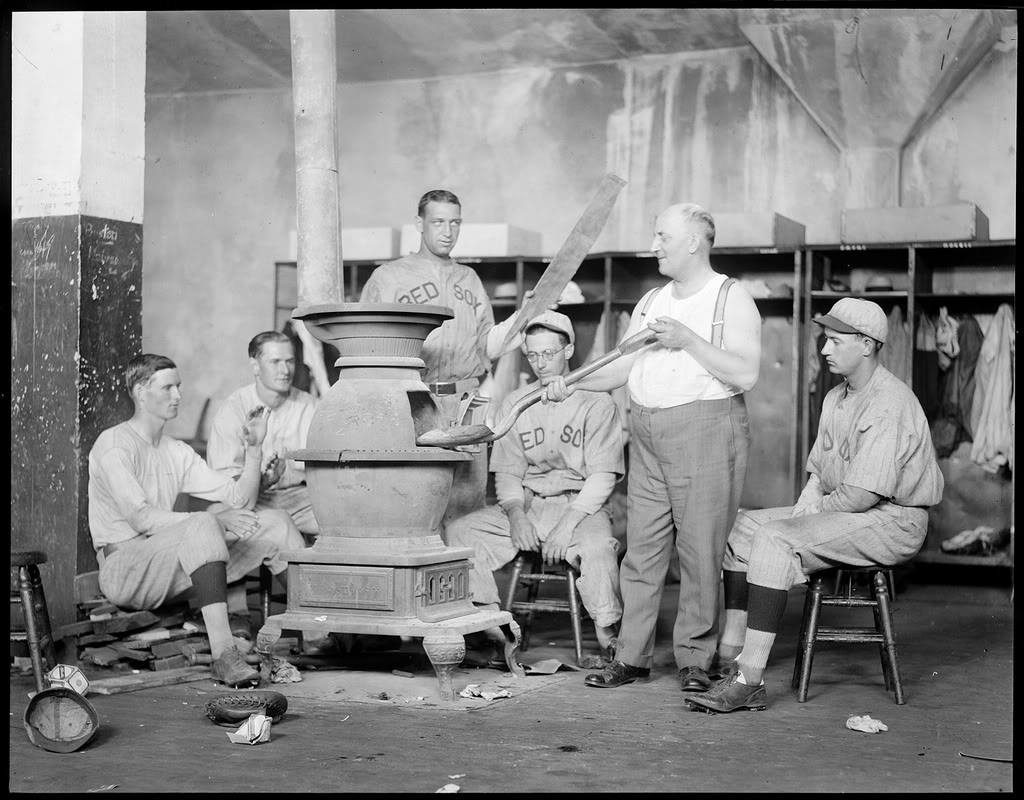THE BASEBALL HISTORY COMES ALIVE BLOG
Please note: As we compose new blog entries, we will now send each one out to all our subscribers as we post them. Here’s a link to see the entire Blog Archives -GL
BASEBALL’S HOT STOVE LEAGUE
All baseball fans know just what the Hot Stove League is. Theoretically, it can be applied to any baseball talk or discussion during the offseason. The term is still used today. On their regional networks in New York, there’s Yankee Hot Stove and Mets Hot Stove, programs devoted to yakking about the players, the teams, possible trades, and signings. They include news stories about the respective teams as well as interviews with players – present, past, and even future. And they’re rerun several times a week so you can’t miss them.
(In the featured photo, we see members of the Red Sox from 1928 sitting around a real “hot stove” in the Red Sox clubhouse. Visible are Charlie Berry (standing) and Danny MacFayden with glasses. Trainer is Bits Bierhalter).
I use the term yakking for the simple reason that today you can find baseball talk everywhere, all year round. It’s almost like there isn’t a real offseason anymore. There are all kinds of speculation, constant analysis, shows about the greatest plays of the year, the top players of the year, reruns of ballgames, panel discussions about almost any baseball subject you choose – free agents, analytics, performance-enhancing drugs, rule changes. In other words constant yakking. Some of you may still enjoy it, but to me, it has become overkill on a large scale. The talking heads are everywhere and every one of them is a self-appointed expert. In other words, the Hot Stove League ain’t what it used to be.
When I was a kid in the 1950s, there was a kind of romanticism about baseball’s offseason. There were just 16 teams, none in Florida, Arizona or California. All were in colder climates where winters were real, and that may even have something to do with the origin of the phrase hot stove league. Back then you had to get all your hot stove information from the radio and, in some ways, that also helped make it special. In fact, when I first started listening to hot stove league radio programs, I actually pictured the broadcasters sitting around one of those potbelly wood-burning stoves. In a symbolic way, that made it an even more warm and cozy experience.
I used to listen to a show on the radio that featured the great sportscaster Marty Glickman. He was joined by Ward Wilson and Bert Lee. They called the show simply Wilson, Glickman, and Lee. They also did a Brooklyn Dodgers pregame show for awhile. Later, Lee left the show and a former pro tennis player named Gussie Moran took his place. She was one of the first women to do a sports broadcast on a regular basis. And in the offseason, they did a hot stove league show. It was on the radio, of course, and I loved listening to it, even if it meant staying up later than I should have.
Maybe back then it was special because you didn’t get a lot of baseball talk in the winter months. There certainly wasn’t the mass communication they have today with television, podcasts and social media all blaring out baseball news and analysis on a daily basis. So back then you grabbed any offSeason baseball talk you could and when you saw the words, Hot Stove League, you knew it was time to listen. In those days it really helped make baseball even more special.
If you’re a baseball junkie there’s nothing wrong with getting a steady dose of it, and it’s easy these days because it’s all over. It wasn’t that way back in the 1950s and ’60s, especially in the offseason. That’s why the Hot Stove League was so important to older fans. And the talk was different then. There weren’t multi-year contracts and free agents, no analytics dictating the way the game should be played and you didn’t really need a scorecard to know the players and teams, and which ones were where. So the hot stove league discussions were about pure baseball, the game and the players and a bit about the history. For us, the Hot Stove League was pure joy. Today it isn’t quite as hot anymore.
As always, we enjoy reading your comments
Here’s a link to see the entire Blog Archives

